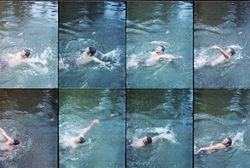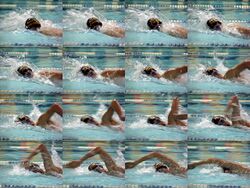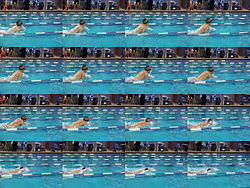Swimming: Difference between revisions
imported>Robert W King |
imported>Karen DeSantis |
||
| Line 7: | Line 7: | ||
The athletic merits of swimming are great; the mass of water provides an element of resistance with every stroke, providing a cardiovascular workout. | The athletic merits of swimming are great; the mass of water provides an element of resistance with every stroke, providing a cardiovascular workout. | ||
==Types of strokes== | ==Types of strokes== | ||
There are different types of repetitive motions, known as strokes, that can be used to swim: the backstroke; the breaststroke; the side-stroke, and "freestyle". | There are different types of repetitive motions, known as strokes, that can be used to swim: the backstroke; the breaststroke; the butterfly; the side-stroke, and "freestyle". | ||
===Backstroke=== | ===Backstroke=== | ||
| Line 19: | Line 19: | ||
[[Image:Freestyle stroke example two.jpg|left|thumb|250px|{{#ifexist:Template:Freestyle stroke example two.jpg/credit|{{Freestyle stroke example two.jpg/credit}}<br/>|}}A side view of a swimmer performing the "freestyle" stroke.]] | [[Image:Freestyle stroke example two.jpg|left|thumb|250px|{{#ifexist:Template:Freestyle stroke example two.jpg/credit|{{Freestyle stroke example two.jpg/credit}}<br/>|}}A side view of a swimmer performing the "freestyle" stroke.]] | ||
Freestyle | Freestyle is a stroke performed while floating face-down in the water. The legs alternate in kicking motion, while the arms alternate "reaching out" to pull the swimmer forward. The majority of the thrust occurs when the outstretched arm breaks the plane of the water, and with arm fully extended is moved from a 9 o'clock position to a 3 o'clock; similar to that of a boat oar. On the side of whichever arm is due for the next stroke, the swimmer turns his head to that opening and takes in a deep breath. As the hand reaches forward, the head returns face-down in the water and the cycle repeats on the opposite side. Again, like the backstroke, the head and torso should remain in a line approximately parallel with the surface of the water, except during the breathe cycle. | ||
===Breaststroke=== | ===Breaststroke=== | ||
[[Image:Breaststroke stroke example one.jpg|right|thumb|250px|{{#ifexist:Template:Breaststroke stroke example one.jpg/credit|{{Breaststroke stroke example one.jpg/credit}}<br/>|}}A profile view of a swimmer performing the "breaststroke" swimming stroke.]] | [[Image:Breaststroke stroke example one.jpg|right|thumb|250px|{{#ifexist:Template:Breaststroke stroke example one.jpg/credit|{{Breaststroke stroke example one.jpg/credit}}<br/>|}}A profile view of a swimmer performing the "breaststroke" swimming stroke.]] | ||
Breaststroke is | Breaststroke is a symmetrical swim stroke. It begins with both hands pressed together directly in front of the breast area of the chest, forcing the elbows off to the side outwards. The knees are also drawn in halfway to the abdomen. The very next motion is the pushing of the hands directly out in front of the swimmer, still placed together, extending the swimmer's position into a straight line. At this moment, the knees and legs begin to come down and seperate to either side. The swimmer's face will begin to come down into the water. Once the arms are fully extended, they part ways with hands facing away from each other. Arms kept stiff, both arms are swung out in tandem until they are perpendicular with the body; the legs providing a powerful "kick" and ending up back together behind the swimmer. At this point the swimmer's face will return to above the surface of the water due to the bodily motions. To repeat, the hands are redrawn inward to the breast-area of the chest; the knees are brought in, and the cycle repeats. Note that the breath should occur when the swimmer's head is pushed up out of the water and the arms are perpendicular to the body. | ||
===Butterfly=== | |||
Butterfly is symmetrical just like the breaststroke. The stroke requires that both arms simultaneously pull backward under the water, then simultaneously recover over the water. Hands must remain at a horizontal level. The kick requires that both legs and feet move up and down vertically at the same time. It is commonly called the dolphin kick because the lower half of the body moves up and down similar to a dolphin swimming. to finish a swimmer must contact the fend of the pool with both hands simulataneously. | |||
==Competitive swimming== | ==Competitive swimming== | ||
Revision as of 08:57, 30 April 2009
Template:TOC-right Swimming describes a large variety of aquatic activities: competitive swimming, recreational swimming, aquatic exercise, water sports (such as water polo, synchronized swimming, underwater hockey), or keeping afloat in order to survive.
It is hard to say if swimming is an instinct; human beings develop for nine months while living in amniotic fluid and while we are babies, the "swimming movement" happens by reflex when we are in a non-static freeform environment (such as being held up in the air, or when being bathed). This motion usually starts two weeks and lasts around five months post-birth.
The athletic merits of swimming are great; the mass of water provides an element of resistance with every stroke, providing a cardiovascular workout.
Types of strokes
There are different types of repetitive motions, known as strokes, that can be used to swim: the backstroke; the breaststroke; the butterfly; the side-stroke, and "freestyle".
Backstroke
The backstroke is performed while floating in the water on one's back. The legs alternate in kicking motions providing propulsion while the arms rotate about the shoulder. The arm stroke is performed in such a way that the greatest amount of momentum provided in the water occurs when the arm breaks the surface when raised straight up, over the top of the head with the palm facing outward (9 o'clock) to a position where the arm "pulls" the swimmer along under the surface of the water at a perpendicular (6 o'clock) with the palm facing up, acting as a paddle. The stroke is continued as the arm is brought up to the surface, palm upward (3 o'clock) and completed as the arm is raised to another perpendicular (12 o'clock) ready for the next iterative stroke. Each arm performs this movement; the other arm beginning the stroke when the first arm breaks the surface of the water over the top of the head, providing a continuous movement.
Throughout the entire stroke, the head and body remain in a line approximately parallel with the surface of the water.
Freestyle
Freestyle is a stroke performed while floating face-down in the water. The legs alternate in kicking motion, while the arms alternate "reaching out" to pull the swimmer forward. The majority of the thrust occurs when the outstretched arm breaks the plane of the water, and with arm fully extended is moved from a 9 o'clock position to a 3 o'clock; similar to that of a boat oar. On the side of whichever arm is due for the next stroke, the swimmer turns his head to that opening and takes in a deep breath. As the hand reaches forward, the head returns face-down in the water and the cycle repeats on the opposite side. Again, like the backstroke, the head and torso should remain in a line approximately parallel with the surface of the water, except during the breathe cycle.
Breaststroke
Breaststroke is a symmetrical swim stroke. It begins with both hands pressed together directly in front of the breast area of the chest, forcing the elbows off to the side outwards. The knees are also drawn in halfway to the abdomen. The very next motion is the pushing of the hands directly out in front of the swimmer, still placed together, extending the swimmer's position into a straight line. At this moment, the knees and legs begin to come down and seperate to either side. The swimmer's face will begin to come down into the water. Once the arms are fully extended, they part ways with hands facing away from each other. Arms kept stiff, both arms are swung out in tandem until they are perpendicular with the body; the legs providing a powerful "kick" and ending up back together behind the swimmer. At this point the swimmer's face will return to above the surface of the water due to the bodily motions. To repeat, the hands are redrawn inward to the breast-area of the chest; the knees are brought in, and the cycle repeats. Note that the breath should occur when the swimmer's head is pushed up out of the water and the arms are perpendicular to the body.
Butterfly
Butterfly is symmetrical just like the breaststroke. The stroke requires that both arms simultaneously pull backward under the water, then simultaneously recover over the water. Hands must remain at a horizontal level. The kick requires that both legs and feet move up and down vertically at the same time. It is commonly called the dolphin kick because the lower half of the body moves up and down similar to a dolphin swimming. to finish a swimmer must contact the fend of the pool with both hands simulataneously.
Competitive swimming
There are a few different categories for competitive swimming. The most common form are distance swims, which are judged in various meter-length categories; the amount of times actually traversed from one end of the pool to the other depends on its length and the distance of that "heat". Swimming races are held in the summer Olympics.
Additionally, there are so called "iron-man" competitions where the distances are much greater. There are records for individuals that have swam such bodies of water as the English Channel.
Recreational swimming
It is not uncommon for either owners of houses equipped with pools or local community pools to host "pool parties", in which participants are encouraged to show up with appropriate swimming attire and various pool toys, such as dive rings, air cushions, foam noodles and inner tubes.
An unusual form of recreation comes from swimmers that choose to swim during the winter. These are known as "Polar Bear Clubs". One such organization, the The Coney Island Polar Bear Club[1] is the oldest winter bathing organization in the United States. During their gatherings, the temperature in the Atlantic Ocean can drop into the low 60 degrees farenheit, with not-unusual lows of 30 degrees given local climate change and wind chill.
References
- ↑ Welcome to Coney Island Polar Bear Club. Coney Island Polar Bear Club (Fall 2007). Retrieved on 2007-10-09.


